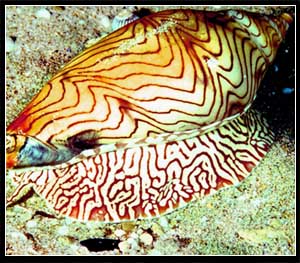Rippling Sands
Swim through the surf zone and just past the breaking waves. The rippling sand below may look like a marine desert with no visible sign of life, but take a closer look. The sandy bottom is alive with a rich and diverse assortment of life.
Watch out for stingrays and fish that pass over the sandy plains, or crabs using their bodies as camouflage to blend into the soft sea floor.
Did you know that...?
- For a long time scientists thought sandy habitats were biological deserts. They now know different.
- One square metre of sand can yield several thousand organisms and hundreds of species.
- The giant marine worm can grow up to two metres long.
What lives here?
- Above the sandy plain:
- Large fish such as flounders, rays and stingarees forage along the sand and mudflats. Sardines and sprats dart about the water while sand whiting feed on the bottom, feasting on worms, small crabs and ghost shrimps.
- On and in the sand:
- The brightly coloured bodies and patterned shells of pipis and sea snails plough through the sand like bulldozers. Look closely to see heart urchins bury themselves, visible only by a few hairs sticking out of the sand.
- Between the sand:
- Slender bodied sea fleas and sea lice slide easily between sand grains and propel themselves through the water with the flick of their tails. Tiny worms less then one millimetre long live between sand grains and graze on microscopic organisms.
Dr B. Diversity tells allScientists know so little about what organisms inhabit the sandy sea floors, that new species are being discovered all the time. We do know these habitats support a huge range of diverse species, many found nowhere else in the world.
Sandy sea floors provide nurseries for shrimps, prawns and young flounder and feeding grounds for many types of fish.
Although our knowledge is limited, scientists think that these groups of species are good indicators of the marine environment's health.
Do whales drop in?Many sandy plains are found in waters too shallow for whales. The whales that come in very close to shore are mostly those that are sick or lost. Some of these get stranded.
Here in the year 2050?A number of human activities threaten sandy plains:
Even with limited knowledge it is clear the submerged sands around southern Australia are unique habitats that need our protection.
- Dredging that removes a deep layer of sand, damaging the delicate organisms.
- Pollution from oil spills, sewage discharge, agricultural herbicides and toxic wastes.
- Collection of animals for bait, such as pipis.
What can you do to help conserve sandy areas?Support the creation of marine national parks and reserves that protect these habitats.
Images Courtesy of the Marine and Coastal Community Network


